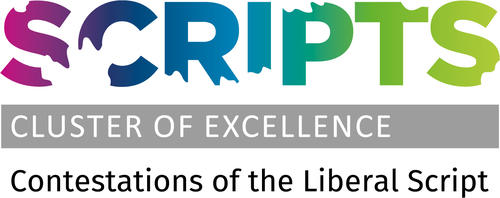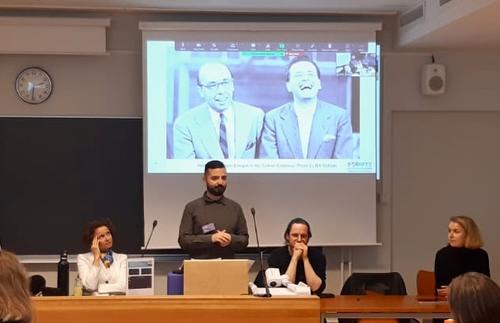SCRIPTS Researchers at the 5th Conference of the New Diplomatic History Network: “Diplomacy Situated: Settings, Personas, Practices”
Jessica Gienow-Hecht, Tobias Klee, Lesar Yurtsever and Marlene Ritter at the New Diplomatic History Conference in Turku, Finland
From May 25th till the 27th, researchers gathered in Turku, Finland, for the 5th Conference of the New Diplomatic History Network under the title "Diplomacy Situated: Settings, Personas, Practices". Together with SCRIPTS Principal Investigator Jessica Gienow-Hecht, three doctoral researchers joined the conference: Tobias Klee, Marlene Ritter, and Lesar Yurtsever. You can read their report below.
News from Jul 04, 2023
Report: 5th Conference of the New Diplomatic History Network: “Diplomacy Situated: Settings, Personas, Practices” (25th-27th May, 2023, Turku, Finland)
“Welcome to the Liberal State: Place Branding as a Diplomatic Practice, 1920s-1950s” (Jessica Gienow-Hecht, Tobias Klee, Marlene Ritter, Lesar Yurtsever)
1. We Can’t Live with You No More: Francesc Macià’s Campaign to Market Catalonia in France in the 1920s
In his presentation, Tobias Klee discussed the failed invasion of Catalonia by Catalan separatist Frances Macià and his subsequent trial in Paris 1926. He argued that Macià used the public attention of the trial and the military insurgency as "Propaganda of the deed", to bring international European attention to Catalonia's struggle for independence. He and his compatriots branded Catalonia as a "liberal place", oppressed by an inherently authoritarian Spain.
During the trial, they depicted Catalonia and France as historically and culturally connected. They argued Catalonia was more akin to France in matters of language, law, and liberal tradition. Further, Catalonia had maintained a commercial, industrious empire during the medieval period, while Catalans themselves were an inherently entrepreneurial, mercantile people. Spain though, due to the influences of islam during the middle ages, had only ever been capable of dominating and exploiting its subjects. It was unable to build democratic institutions and lacked the achievements of the Enlightenment period. France had further promised Catalonia independence on multiple occasions throughout history. Macià and his compatriots aligned Catalonia with Republican France and its ideals, whereas Spain appeared as a feudal, despotic monarchy, akin to the Ancien Régime.
The presentation followed three main themes: 1. Nation branding is an essential tool for sub-state nationalities; 2. These nationalities had to brand themselves against the foil of the state they belong to. Catalonia can only appear liberal through portraying Spain as illiberal; 3. Catalonia's strategy of nation branding not only served them externally, but also internally, as it lent popular support to Macià.
In the discussion, Tobias Klee addressed two main questions: 1. What could Catalonia have done differently to actually win the support of France for its struggle? 2. Can we describe Catalan separatism in the 1920s as radical? To the first point he argued that it was geopolitically inopportune for France to support Catalonia against Spain, despite any liberal, democratic similarities the separatists invoked between both peoples. To the second point, he argued that in comparison to other nationalist movements during the time period, Catalan separatists were neither more nor less radical. He further posed the question, if choosing violence against instead of negotiating with a military dictatorship is really such a radical move for an oppressed people.
2. “A Mecca for Jazz Enthusiasts”: The Turkish Embassy in the U.S., in the 1930s and 1940s
During the second presentation, Lesar Yurtsever talked about how Turkish state and non-state actors used music to brand Turkey as a liberal state in the United States. He focused on one chapter of his project, which explores the role of the Ertegün brothers in breaking down racial barriers in Washington, D.C. during the 1930/40s. Motivated by their passion for jazz music, the young sons of the Turkish ambassador invited African American jazz musicians to the Turkish embassy and turned the building into a liberal, vibrant jazz hub for the musicians. The latter could freely and equally jam together with white musicians, despite the prevalent racism outside the embassy’s walls.
Lesar Yurtsever highlighted the contrasting perspectives of these events. For African Americans, the Ertegün brothers emerged as a beacon of liberalism, promoting inclusivity and minority voices. But these efforts can also be seen as a departure from the policies of the brothers’ home country. They did not reflect the repressive measures against dissidents and minority groups in the modernization process of the Turkish government.
The following debate centered on the political dimension of the brothers' passion for jazz music. Lesar Yurtsever argued that the brothers' activities seemed to have a solely "private" character since their defiant actions were perhaps typical of youngsters. Nevertheless, as sons of the Turkish ambassador, the jam sessions by African Americans at the Turkish embassy inevitably had a political dimension. Their father held the Turkish political rights over the embassy building, which prevented racist voices from interfering. In the same vein, ambassador Ertegün took a significant risk by granting African Americans access to his embassy. From a U.S. perspective, the notion of equal treatment for African Americans was incomprehensible during that era. The complaints by U.S. congressmen could undermine Turkish efforts in building good relations with the U.S. Lesar Yurtsever emphasized that his archival research would delve into the reactions of both the Turkish and U.S. governments in response to these risky events, as this aspect has been missing in the existing literature.
3. “Europe” as a Liberal Brand at the Expo 58 (Marlene Ritter)
The more politically adept visitors to the Expo 58 in Brussels were probably surprised to find two European pavilions in the so-called international section: the pavilion shared by the Council of Europe and the OEEC and the pavilion of the European Coal and Steel Community. In the third presentation, Marlene Ritter interpreted these three exhibitions (1) as materialisations of the early years of Western European integration and the complex institutional landscape at the time; (2) as instances of the world fair as a strongly normed framework of place branding; and (3) as an example of Europe as a liberal brand in the making, co-constructed by three different organisations in two separate pavilions.
Albeit with different foci, these then still relatively newly founded Western European organisations exhibited their liberal self-images, and hence, three varieties of Europe as a liberal brand. And beyond the specific exhibits, the exhibitions displayed some of the general characteristics of liberal place branding: They claimed a moral high ground, presenting European integration as simply the right and most progressive thing to do. They dressed themselves in universality, much like the Expo 58 itself, concealing the ‘first world protagonism’ and the imperial hegemony over what was framed as a universal exhibition. Furthermore, the curators of the European exhibitions tended to ignore what Homi Bhabha once termed the ‘sacred cow of liberalism’, meaning the contradictions within the liberal tradition – be it the colonial histories of European member states or the exclusiveness of Europe as a liberal place. And above all, the “Eurocrats” behind the exhibitions faced an old dilemma of self-proclaimed liberals: Their pavilions were supposed to keep up with the fierce competition on the exhibition grounds. At the same time, they should not be perceived as manipulative, and therefore illiberal. All three exhibitions therefore framed their advertising of Europe as non-propaganda or mere “information”. What they thereby disguised is that even a project as rational and liberal as “Europe” needed to be sold.
4. Jessica Gienow-Hecht, “The Proud State: How Countries Have Marketed Themselves as Liberal Regimes”
In her comparative discussion, Jessica Gienow-Hecht considered all three cases – one substrate, one state, one supra state – by using four different criteria: campaigns; legitimacy, temporality, audiences. She pointed out the surprising amount of vagueness when it comes to self-representation of the liberal state. Liberalism in Catalonia was, essentially, self-determination – to be able to not be part of Spain but it was not quite clear what else. In the case of the Turkish embassy in Washington, it was freedom of speech but that’s complicated since, as Lesar Yurtsever pointed out, jazz is originally less improvisatory than hierarchical. And in the case of the European Expo, it’s essentially a place, a space where people cherish specific values.
One common attitude among all three cases, she observed, was an expectation that key words couched in the terminology of the liberal script – liberty, equality, opportunity, participation, self-determination – would lead people invariably to “get it.” Yet, the fact of the matter is that these campaigns frequently did and do not work out as planned or produce opaque results. Indeed for all the current-day efforts in the field of liberal cultural diplomacy, today the number of fully democratic regimes is receding. The question, lingering, then is: Is there something wrong with the product itself – liberalism? Or, is there something wrong with the marketing of the product? These papers, Gienow-Hecht argued, point toward the latter: Liberal states do not market themselves well. Campaigns are often informed adhoc by moments of crisis, reactive and proactive; they sometimes seem to lack legitimacy; and the outcome is unpredictable since audiences react erratically and not as expected.

